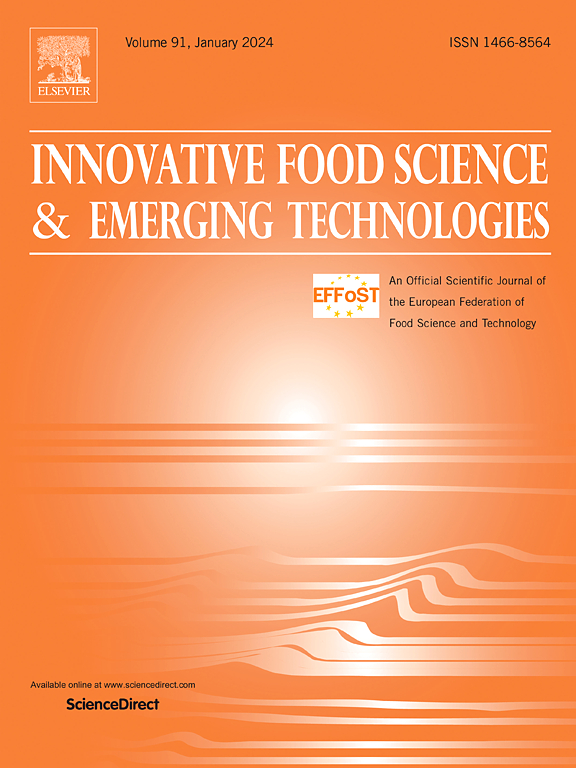苹果和蔓越莓汁中嗜酸地酸环杆菌孢子的欧姆加热失活
IF 6.3
1区 农林科学
Q1 FOOD SCIENCE & TECHNOLOGY
Innovative Food Science & Emerging Technologies
Pub Date : 2025-03-31
DOI:10.1016/j.ifset.2025.104010
引用次数: 0
摘要
本工作探讨了欧姆加热(OH)灭活苹果和蔓越莓汁中的嗜酸地酸芽孢杆菌孢子的方法,并与常规加热(CH)进行了比较。实验在不同场强(30、40、50 V/cm)和终点温度(90°C、100°C、110°C)下进行,CH实验设计与OH的加热速率相匹配。在100°C下测定孢子失活动力学,并使用对数线性、Weibull、修正Gompertz和经验s型模型建模。与CH相比,OH始终实现更快、更完全的孢子失活,特别是在110°C时,OH将活孢子从107-108 CFU/ml的初始孢子群中减少到检测限(100 CFU/ml)以下,即使在最低场强测试中也是如此。一个关键的发现是,无论加热方式是OH还是CH,孢子失活不仅受到温度的影响,还受到达到目标温度的速度的影响,这突出了加热速度的重要性。此外,电场强度和温度之间的协同作用进一步加速了致死率。我们的工作表明,加速失活可以在没有保温时间的情况下获得,特别是当高场强和温度同时使用以达到最终设定点时,这表明可以使用这种方法控制酸地菊,并有可能改善果汁质量。本文章由计算机程序翻译,如有差异,请以英文原文为准。
Ohmic heating inactivation of Alicyclobacillus acidoterrestris spores in apple and cranberry juice
This work explored the use of ohmic heating (OH) for inactivating Alicyclobacillus acidoterrestris spores in apple and cranberry juices in comparison to conventional heating (CH). Experiments were conducted at different field strengths (30, 40, 50 V/cm) and end-point temperatures of 90 °C, 100 °C, 110 °C, with CH trials designed to match OH's heating rates. The spore inactivation kinetics were determined at 100 °C, and modeled using log-linear, Weibull, modified Gompertz, and empirical sigmoid models. OH, consistently achieved faster and more complete spore inactivation compared to CH, particularly at 110 °C, where OH reduced viable spores below the detection limit (100 CFU/ml) from an initial spore population in the range of 107–108 CFU/ml, even at the lowest field strength tested. A key finding was that regardless of whether the mode of heating is OH or CH, spore inactivation was influenced not only by temperature but also by the rate at which the target temperature is reached—highlighting the importance of heating rate. In addition, the synergy between electric field strength and temperature resulted in further acceleration of lethality. Our work showed that accelerated inactivation may be obtained without a holding period, especially when high field strengths and temperatures are used simultaneously to achieve a final set point, suggesting that A. acidoterrestris may be controlled using this approach, with potential improvements in juice quality.
求助全文
通过发布文献求助,成功后即可免费获取论文全文。
去求助
来源期刊
CiteScore
12.00
自引率
6.10%
发文量
259
审稿时长
25 days
期刊介绍:
Innovative Food Science and Emerging Technologies (IFSET) aims to provide the highest quality original contributions and few, mainly upon invitation, reviews on and highly innovative developments in food science and emerging food process technologies. The significance of the results either for the science community or for industrial R&D groups must be specified. Papers submitted must be of highest scientific quality and only those advancing current scientific knowledge and understanding or with technical relevance will be considered.

 求助内容:
求助内容: 应助结果提醒方式:
应助结果提醒方式:


